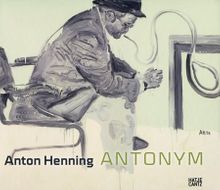ARTIST MONOGRAPHS
|
|
in stock $110.00 Free Shipping UPS GROUND IN THE CONTINENTAL U.S. |
 Anton Henning: Even More Modern
Anton Henning: Even More Modern
Published by Kerber.
Edited with text by Wolfgang Ullrich.
This publication retraces and interprets the development of Berlin-based artist Anton Henning’s (born 1964) works between 1992 and 2017 from an art-historical perspective, specifically outlining the stylistic devices of classical modernism that have persisted in his paintings.
PUBLISHER
Kerber
BOOK FORMAT
Clth, 11 x 13.25 in. / 208 pgs / 156 color / 148 bw.
PUBLISHING STATUS
Pub Date 8/28/2018
Out of print
DISTRIBUTION
D.A.P. Exclusive
Catalog: FALL 2018 p. 187
PRODUCT DETAILS
ISBN 9783735640215 FLAT40
List Price: $100.00 CAD $132.50
AVAILABILITY
Not available
STATUS: Out of print | 00/00/00 For assistance locating a copy, please see our list of recommended out of print specialists |
 Anton Henning: Chapardages, Style & Volupté
Anton Henning: Chapardages, Style & Volupté
Published by Kerber.
Edited and with text by Aeneas Bastian.
PUBLISHER
Kerber
BOOK FORMAT
Hardcover, 9.5 x 12 in. / 64 pgs / 36 color.
PUBLISHING STATUS
Pub Date 4/30/2013
Out of print
DISTRIBUTION
D.A.P. Exclusive
Catalog: SPRING 2013 p. 193
PRODUCT DETAILS
ISBN 9783866786967 TRADE
List Price: $35.00 CAD $47.50
AVAILABILITY
Not available
STATUS: Out of print | 00/00/00 For assistance locating a copy, please see our list of recommended out of print specialists |
 Anton Henning: 20 Jahre Dilettantismus
Anton Henning: 20 Jahre Dilettantismus
Published by Richter Verlag.
Text by Joerg Bader.
PUBLISHER
Richter Verlag
BOOK FORMAT
Hardcover, 9 x 12.5 in. / 125 pgs / illustrated throughout.
PUBLISHING STATUS
Pub Date 2/1/2009
Out of print
DISTRIBUTION
D.A.P. Exclusive
Catalog: SPRING 2009 p. 162
PRODUCT DETAILS
ISBN 9783937572901 TRADE
List Price: $60.00 CAD $70.00
AVAILABILITY
Not available
STATUS: Out of print | 11/28/2010 For assistance locating a copy, please see our list of recommended out of print specialists |
 Anton Henning: Antonym
Anton Henning: Antonym
Published by Hatje Cantz.
Edited by Reinhard Spieler, Ulrike Lorenz. Text by Alexander Eiling, Stefanie Müller.
PUBLISHER
Hatje Cantz
BOOK FORMAT
Hardcover, 11 x 9.5 in. / 218 pgs / 110 color.
PUBLISHING STATUS
Pub Date 11/30/2009
Out of print
DISTRIBUTION
D.A.P. Exclusive
Catalog: FALL 2009 p. 135
PRODUCT DETAILS
ISBN 9783775724456 TRADE
List Price: $45.00 CAD $55.00
AVAILABILITY
Not available
STATUS: Out of print | 00/00/00 For assistance locating a copy, please see our list of recommended out of print specialists |
 Anton Henning: Und Immer Eine Gute Linie
Anton Henning: Und Immer Eine Gute Linie
Published by Richter Verlag.
Edited by Klaus Gallwitz. Text by by Oscar van den Boogaard, Heike Henze-Bange.
Born in 1964 in Berlin, Anton Henning is represented in New York by Zach Feuer Gallery. His 2006 show there was reviewed thus by The Washington Post: "Who knows what to do with work by the German artist Anton Henning? It doesn't fit any of the normal pigeonholes of contemporary art. It doesn't make clear what its goals could be, or how it relates to other works we might have seen. That's what makes it so intriguing."
PUBLISHER
Richter Verlag
BOOK FORMAT
Hardback, 8.75 x 11 in. / 96 pgs / 87 color.
PUBLISHING STATUS
Pub Date 2/1/2008
Out of print
DISTRIBUTION
D.A.P. Exclusive
Catalog: SPRING 2008 p. 173
PRODUCT DETAILS
ISBN 9783937572772 TRADE
List Price: $55.00 CAD $65.00
AVAILABILITY
Not available
STATUS: Out of print | 12/1/2010 For assistance locating a copy, please see our list of recommended out of print specialists |

